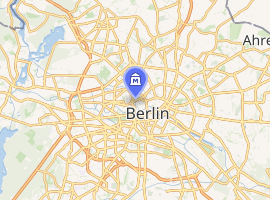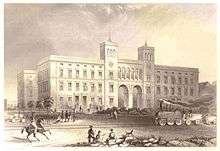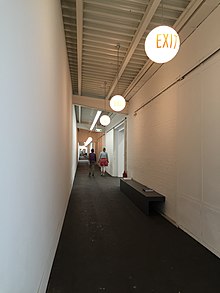Hamburger Bahnhof
Hamburger Bahnhof is the former terminus of the Hamburg-Berlin Railway in Berlin, Germany, on Invalidenstrasse in the Moabit district opposite the Charité hospital. Today it serves as a contemporary art museum, the Museum für Gegenwart, part of the Berlin National Gallery.
 | |

| |
| Established | 1996 |
|---|---|
| Location | Invalidenstraße 50-51, 10557 Berlin, Germany |
| Visitors | 250,000 (2007) |
| Director | Eugen Blume |
| Curator | Britta Schmitz |
| Website | (in English) Hamburger Bahnhof |
Original use as a railway station

The station was built to Friedrich Neuhaus's plans in 1846/47 as the starting point of the Berlin–Hamburg Railway. It is the only surviving terminus building in Berlin from the late neoclassical period and one of the oldest station buildings in Germany.
The building has not been used as a station since 1884, when northbound long distance trains from Berlin began leaving from Lehrter Bahnhof (now Berlin Hauptbahnhof), just 400 m to the southwest.
Use as a railway museum
On 14 December 1906, the former station became home to the new Royal Museum of Building and Transport (German: Königliches Bau- und Verkehrsmuseum), supervised by the Prussian State Railways, which was incorporated into the new all-German national railways Deutsche Reichsbahn in 1920. The term 'royal' was dropped with the end of the Prussian monarchy in 1918. The museum attracted crowds and was twice extended with additional wings to the left and right of the main building in 1909–11 and 1914–16. Hit by Allied bombing in 1944, the museum was closed; however, most of the collection survived.
After the war, although located in what had become the British sector of Berlin, the museum remained under the supervision of the East German Reichsbahn, which—by agreement of all the Allies—operated the railways in all of Berlin in addition to East Germany. The Reichsbahn's East German management had no interest in reopening a museum now located in West Berlin, but only in the exhibits, which the Western Allies did not allow to be brought to the East. In 1984 the Reichsbahn transferred both the building and the collection into Western hands. The collection included examples of industrial and technological developments of its time—many locomotives and rolling stock—and was thus a precursor of the Museum of Technology, which now displays many of the exhibits once shown in Hamburger Bahnhof. In 1987, the empty halls were used for temporary exhibitions.
Rebirth as an art museum
Berlin Circle von Richard Long, 2005


In the mid-1980s the Berlin entrepreneur Erich Marx offered his private collection of contemporary art to the city. The Berlin Senate decided in 1987 to establish a museum of contemporary art in the former railway station. The Prussian Cultural Heritage Foundation agreed to operate the museum as part of the National Gallery. A competition for the renovation of the station was announced by the Senate in 1989, and was won by the architect Josef Paul Kleihues.
Between 1990 and 1996, Kleihues refurbished the building, and in November 1996 the 108,000 sq ft (10,000 m2)[1] museum was opened with an exhibition of works by Sigmar Polke. The Museum für Gegenwart exhibits modern and contemporary art. Permanent loans from the Marx collection, including works by artists such as Joseph Beuys, Anselm Kiefer, Robert Rauschenberg, Cy Twombly and Andy Warhol, are on permanent display.[2] An emphasis of the Nationalgalerie collection is art on video and film, including a collection of 1970s video art—a gift of Mike Steiner—and the Joseph Beuys media archives.
Rieckhallen
In 2004, another part of the building complex, the former Güterbahnhof, which is connected to the Hamburger Bahnhof, was rebuild to an exhibition hall, the Rieckhallen, for the Friedrich Christian Flick Collection.[3] Between 2004 and 2010, the Museum für Gegenwart exhibited parts of the Friedrich Christian Flick Collection, whose main focus is on the late 20th century. The collection contains large-format works by Paul McCarthy, Jason Rhoades, Rodney Graham, Peter Fischli and David Weiss, and Stan Douglas, including elaborate installations and complex filmic spaces. Due to its connection with the Flick family, the display (which had been rejected by the city of Zurich) gave rise to protests in 2004. Flick nonetheless agreed to lend 1,500 works to the Berlin State Museums, initially for seven years. He then extended the loan for another ten years to 2021.[4] He also invested 8 million euros into having architects Kuehn Malvezzi renovate the Rieckhallen, the former depot of the German Imperial Railway, to showcase his works.[5]
In 2020, the museum building's owner – Austrian property company CA Immo – announced plans to demolish the Rieckhallen after the rental contract expires in September 2021. The planned demolition prompted Flick to end the loan of his collection. Shortly after, the Federal Agency for Real Estate (BIMA) entered into negotiations to buy the Hamburger Bahnhof.[6]
See also
References
- Rebecca Schmid (April 24, 2018), In Berlin, Looking at a Familiar Art Collection With New Eyes New York Times.
- Carol Vogel (November 1, 1996), New Museum and an Art Fair New York Times.
- "Die Sammlung in Berlin | FRIEDRICH CHRISTIAN FLICK collection". Retrieved 2020-06-20.
- Catherine Hickley (April 24, 2020), Berlin museums announce ‘painful’ end to loan of 'one of the world’s most outstanding contemporary art collections' The Art Newspaper.
- Guy Chazan (June 24, 2020), Art world says goodbye to Berlin Financial Times.
- Catherine Hickley (July 1, 2020), German government seeks to buy Hamburger Bahnhof museum from investor The Art Newspaper.